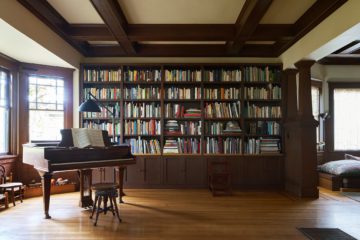Julie Lasky in The New York Times:
 At the turn of the millennium, Reid Byers, a computer systems architect, set out to build a private library at his home in Princeton, N.J. Finding few books on library architecture that were not centuries old and in a dead or mildewed language, he took the advice of a neighbor across the street, the novelist Toni Morrison. Ms. Morrison “once famously said if there is a book you want to read and it doesn’t exist, then you must write it,” recalled Mr. Byers, 74, in a video chat from his current home, in Portland, Maine. The project stretched over a generation and culminated this year in a profusely illustrated, detail-crammed, Latin-strewn and yet remarkably unstuffy book called “The Private Library: The History of the Architecture and Furnishing of the Domestic Bookroom,” published by Oak Knoll Press.
At the turn of the millennium, Reid Byers, a computer systems architect, set out to build a private library at his home in Princeton, N.J. Finding few books on library architecture that were not centuries old and in a dead or mildewed language, he took the advice of a neighbor across the street, the novelist Toni Morrison. Ms. Morrison “once famously said if there is a book you want to read and it doesn’t exist, then you must write it,” recalled Mr. Byers, 74, in a video chat from his current home, in Portland, Maine. The project stretched over a generation and culminated this year in a profusely illustrated, detail-crammed, Latin-strewn and yet remarkably unstuffy book called “The Private Library: The History of the Architecture and Furnishing of the Domestic Bookroom,” published by Oak Knoll Press.
…“Entering our library should feel like easing into a hot tub, strolling into a magic store, emerging into the orchestra pit, or entering a chamber of curiosities, the club, the circus, our cabin on an outbound yacht, the house of an old friend,” he writes. “It is a setting forth, and it is a coming back to center.” Mr. Byers coined a term — “book-wrapt” — to describe the exhilarating comfort of a well-stocked library. The fusty spelling is no affectation, but an efficient packing of meaning into a tight space (which, when you think of it, also describes many libraries). To be surrounded by books is to be held rapt in an enchanted circle and to experience the rapture of being transported to other worlds. So how many books does it take to feel book-wrapt? Mr. Byers cited a common belief that 1,000 is the minimum in any self-respecting home library. Then he quickly divided that number in half. Five hundred books ensure that a room “will begin to feel like a library,” he said. And even that number is negotiable. The library he kept at the end of his bunk on an aircraft carrier in Vietnam, he said, was “very highly valued, though it probably didn’t have 30 books in it.”
“What’s five times 40?” Alice Waters, the chef and food activist, recently asked. (The question was rhetorical.) “Two hundred, 400, 600, 800,” she calculated, apparently scanning the bookcases around her and adding up their contents (she was speaking on the phone). “And then probably another 800,” she said, referring to other rooms in her Berkeley, Calif., bungalow.
More here.
